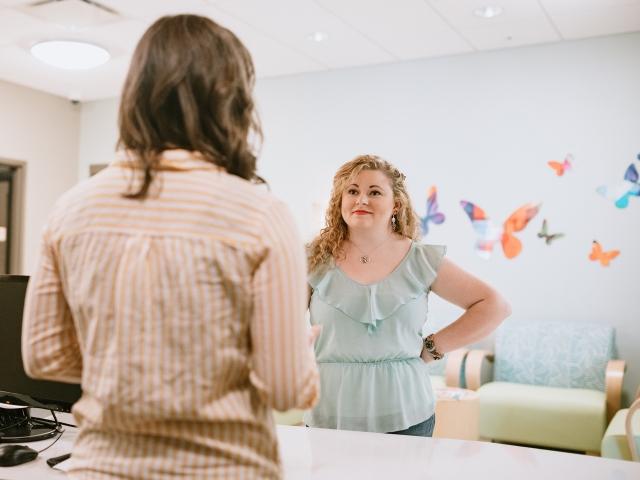What is atypical anorexia?
Atypical anorexia is an eating disorder that is nearly identical to anorexia. The difference? While people with anorexia are at significantly low body weights, people with atypical anorexia weigh in the “normal” range or live in larger bodies.
People of all genders, shapes and sizes can suffer serious, and even fatal, complications from this eating disorder.
Atypical anorexia in the DSM-5
Atypical anorexia falls under the DSM-5 category as an other specified feeding or eating disorder (OSFED). And the number of people diagnosed with this eating disorder is growing. A recent study found that between 25-40% of patients in inpatient eating disorder treatment centers have atypical anorexia. [1,2]
Atypical anorexia vs. anorexia
There are few differences in how anorexia and atypical anorexia affect people. The primary difference is that people with anorexia have a lower body weight to height ratio than people with atypical anorexia.
While the two eating disorders are similar, since people with atypical anorexia do not appear underweight, they are less likely to receive eating disorder treatment compared to individuals with anorexia who look underweight. [3]
Real People. Real Stories. Real Progress.
Our expert care teams ensure people of all ages, races and gender identities get the exact support they need at each stage of their recovery. With the right care, lasting healing is possible – and we have the data to show it.
73% of patients no longer reported significant eating disorder symptoms
Causes of atypical anorexia
Atypical anorexia can have multiple causes, including genetic, biological, psychological, social and cultural factors.
Genetic and biological causes
All mental health conditions are biological in nature, and eating disorders are no different. Atypical anorexia, like other eating disorders, is known to have a strong genetic link. If someone in your family has had an eating disorder, you may be more likely to develop an eating disorder. This does not mean that parents are to blame for a child’s eating disorder. In fact, family support is instrumental at helping people overcome eating disorders.
Psychological risk factors
Individuals may be more likely to develop an eating disorder if they are already struggling with mental health issues like anxiety, depression, another mood disorder, or substance use. Other traits highly associated with atypical anorexia and other eating disorders include:
- A history of trauma
- Body image issues (body dysmorphia)
- Perfectionism
- Rigidity in thinking or behavior
- Low self-esteem
- Interpersonal problems
- Trouble with emotional regulation
If you recognize yourself in some of these personality traits, you may be at a greater risk for developing an eating disorder.
Social and cultural causes
Another risk factor for eating disorders is being exposed to social and cultural messages proclaiming that a certain type of body is “better” than others.
If you hear repeated messages about what your body “should” look like, you may take drastic measures to change your body to look more like that “ideal” body type. This may lead you to engage in behaviors aimed at losing weight or preventing weight gain, including dieting, purging or exercising excessively — all signs of atypical anorexia.
Diet culture messaging
Individuals can be exposed to these social and cultural messages in many ways via diet culture messaging:
- Friends, family members, coaches, dance teachers or others
- The internet, magazines, TV and movies
- Social media apps, where Photoshop, filters and photo editing are common
- Celebrities and fitness influencers
- Messaging from diet and weight-loss companies (a multi-billion-dollar industry)
People of all ages and all genders can be exposed to these messages, increasing the risk for eating disorders.
Atypical anorexia in athletes
Sports are a great way for young people to get exercise, socialize and build self-esteem. However, all sports can potentially increase the risk for developing eating disorders — and this is true for people of all genders.
Trying to achieve the ideal athletic body or attempting to improve performance through increased training and diet changes can lead to eating disorder thoughts and behaviors like:
- Restricting food to lower calorie intake
- Bingeing and/or purging (through vomiting, laxatives, or other means)
- Exercising excessively (running miles a day even when injured)
Some athletic coaches and dance teachers continue to encourage weight loss in young athletes — via any means necessary. This harmful practice continues even though dieting and food restriction can lead to health complications and decreased athletic performance.
How diets lead to eating disorders
Other risk factors for the development of atypical anorexia include being overweight, being body shamed or teased about one’s weight, or having a history of dieting.
- A study of teenagers found that 40% of females who were “overweight” and 20% of males who were “overweight” were engaging in eating disorder behaviors. [4]
- Another study found that 70% of patients with atypical anorexia had been “overweight” or “obese” in the past while only 12% of people with anorexia had been “overweight” or “obese.” [5]
- Further research found that people with atypical anorexia were teased about their weight more often than others as they were growing up. [6]
Being LGBTQ+ increases risk
People who identify as LGBTQ+ are far more likely to experience mental health problems, including eating disorders, than the general public. People who identify as transgender, gender-diverse or gender-non-conforming have higher rates of atypical anorexia than people who identify as male or female. [1]
Atypical anorexia symptoms
The symptoms of atypical anorexia are similar to anorexia: a severe restriction of daily food intake and engaging in behaviors to avoid weight gain, like dieting, fasting or excessive exercise.
Mental health symptoms in people with atypical anorexia can include:
- An intense fear of gaining weight or fear of being in a larger body
- A drive to change one’s weight, body size or shape, at any cost
- Dissatisfaction with one’s body size, shape or appearance, a distorted body image or body dysmorphic disorder
- Low self-esteem, mood swings, anxiety or depression
- Trouble concentrating or focusing
- Fatigue
- Suicidal thoughts or self-harm
Many people with atypical anorexia believe that they are not sick enough to need treatment because they are not underweight.
But the weight loss or sustained calorie restriction associated with atypical anorexia can cause serious problems.
Signs to watch for
If you, or someone you care about, is preoccupied with food, body weight, size or shape, or have unusual eating behaviors, it may be time to seek professional help for an eating disorder.
Do these signs of atypical anorexia seem familiar?
- Increased irritability, low self-esteem or moodiness
- Skipping meals or avoiding eating with others
- Being overly focused on nutrition labels or calorie counts
- Avoiding certain foods or food groups
- Binge eating to numb painful emotions
- Trouble regulating emotions
- Frequent weighing or checking one’s body in mirrors
Some people with atypical anorexia may not have any noticeable physical symptoms.
However, even though physical symptoms are absent, the individual may still be suffering emotionally.
Physical health risks
The physical complications associated with atypical anorexia are as serious as the complications associated with anorexia. As people restrict their food intake, they become at risk for a number of serious problems, including:
- Hair loss or thinning hair
- Fine hair growth on the body (lanugo)
- Bradycardia (abnormally low heart rate)
- Low blood pressure
- Loss of bone mineral density
- Hormone changes or reproductive health issues
- Injuries that are slow to heal or stress fractures
- Fatigue
- Gastrointestinal issues
Notably, the medical condition of patients with atypical anorexia can be as bad, if not worse, than patients with anorexia. [6]
While individuals with atypical anorexia may not appear to be underweight based on body mass index (BMI) alone, if they lose a significant amount of weight in a short amount of time (or if they restrict calories for an extended period of time) they can experience symptoms of malnutrition. [7]

How can I be malnourished if I’m not underweight?
Contrary to popular belief, malnutrition can occur at all body weights. [7] Malnutrition can be caused by:
- Being on a very restrictive diet
- Losing a significant amount of weight (even if you are still within or above the “normal” body mass index (BMI) range) [1]
- Depriving yourself of calories for an extended period of time, even if your body has resisted weight loss [1]
Signs of malnutrition to watch for include:
- Fatigue
- Weakness
- Trouble concentrating
- Dizziness
- Vitamin deficiencies
Even if you are not clinically underweight, any rapid, or significant weight loss can lead to serious medical complications.
The good news is that many of the physical health risks associated with atypical anorexia can resolve with eating disorder treatment.
Is atypical anorexia dangerous?
Since people with atypical anorexia do not appear to be visibly emaciated, providers are less likely to refer these individuals out for eating disorder treatment.
This means that people with this eating disorder, especially at higher weights, may not get the help they need and deserve.
Of great concern, people with eating disorders may be at risk of bradyarrhythmia, raising the risk of early death. [2]
Atypical anorexia is also associated with a rise in suicidal thoughts.
Eating disorders and suicidal thoughts
Having suicidal thoughts or making a plan to end one’s life means that an individual is in severe pain and their life may be in danger.
If you or someone you care about is having thoughts of suicide, get help now by going to the emergency room or calling 988, the Suicide and Crisis Lifeline.
Atypical anorexia treatment
Atypical anorexia treatment utilizes a variety of interventions to help individuals overcome eating disorder thoughts and behaviors. Treatment team members collaborate to provide medical and nutritional support, individual therapy, group therapy, family therapy and more.

Our atypical anorexia treatment approach
Medical stabilization
Patients with atypical anorexia may require medical stabilization at the start of treatment to address unresolved medical complications.
When patients arrive for treatment here at Eating Recovery Center (ERC), here is what happens:
- One of the first things the treatment team will do is run labs to assess for symptoms of malnutrition.
- Medical doctors and psychiatrists monitor and support patients who are acutely ill.
- Psychiatric medicines and other medications are prescribed to support healing.
- Nursing professionals work closely with the treatment team to address atypical anorexia complications, providing medical care when emergency medical intervention is needed
Individual therapy
Eating disorder therapy is an integral part of treatment. Experienced eating disorder clinicians work one on one with patients, applying a number of evidence-based clinical interventions to support behavioral change. Therapists introduce coping skills to patients, and challenge negative thought patterns.
Some of the evidence-based therapies used in treatment include:
- Acceptance and Commitment Therapy (ACT)
- Cognitive Behavioral Therapy (CBT)
- Dialectical Behavioral Therapy (DBT)
- Radically Open Dialectical Behavior Therapy (RO DBT)
- Exposure Therapy
Co-morbid mental health conditions, including anxiety, depression, mood disorders and others are also addressed in therapy.
Group therapy
Group therapy is another critical component of eating disorder treatment. In group therapy:
- Patients benefit from peer and professional support
- Individuals learn how to resolve and repair destructive eating and exercise routines, strict food rules and harmful eating disorder thoughts and behaviors
- Recovery skills and relapse prevention skills are taught while patients work on body acceptance and body image issues
- Experiential therapies including art, psychodrama, mindfulness, movement and yoga are also incorporated into the eating disorder treatment program.
Family therapy
A family-centered approach to treatment is critical. Family members and other members of the support-system play a major role in an individual's recovery at all ages of the lifespan.
Family-based treatment and emotion focused family therapy (EFFT) empower parents, partners and others to become agents of change for their loved ones, supporting them in sustaining long-term recovery.
In family therapy, education is provided to parents, partners, family members and loved ones to help them better understand the impact and how to overcome the eating disorder.
Virtual treatment
The growing field of virtual eating disorder treatment provides a more flexible option for treatment, allowing individuals to work with experienced treatment providers from the comfort of home.
Virtual eating disorder treatment experts provide evidence-based nutritional counseling and therapeutic treatment. Interventions in virtual treatment are similar to the therapeutic offerings listed here.
Atypical anorexia recovery
When an individual starts treatment, they receive medical, nutritional and therapeutic care from experienced eating disorder professionals.
Groups, community meetings, nutritional support and individual therapy all support the individual’s recovery by:
- Addressing physical health effects and medical complications
- Helping patients return to regular eating habits and patterns
- Improving mental health, body image and mood
In treatment, each patient receives an individualized eating disorder treatment plan emphasizing skill building to promote recovery after treatment.
When an individual completes treatment, aftercare planning and alumni services provide a plan of action and continuity of care to maintain the progress made in treatment.
Eating disorder treatment for those with higher weights
Providers are more likely to refer individuals with visibly low body weights to eating disorder treatment. Conversely, people with atypical anorexia, often at “normal” or higher weights, may not be referred out for treatment, despite having multiple physical and mental health complications.
This points to the need to educate healthcare professionals on atypical anorexia and the severity of the illness, regardless of patient weight at time of assessment — or their weight history. It’s important to seek help for restrictive thoughts and behaviors before the illness worsens and medical complications intensify.
Nutritional counseling for eating disorders
Once the patient is medically stable, one of the first goals of treatment will be to re-introduce standard eating habits as a way to normalize eating behaviors and food intake.
At ERC, patients meet with registered dietitians regularly throughout treatment. Since many patients are nervous or even unwilling to eat in treatment, mealtime support is supervised by behavioral health counselors.
Registered dietitians and clinicians are also available as needed. Education on food portions, food plating and nutrition fundamentals is provided.
Atypical anorexia treatment programs
Here at ERC, we offer the full continuum of care for individuals with atypical anorexia and other eating disorders. Learn about the different levels of care here.
Find help for atypical anorexia
Unfortunately, many individuals with atypical anorexia will not seek help because they don’t think they are “sick enough.” And some healthcare providers refuse to refer people with atypical anorexia out for treatment because they appear to be at a “healthy” weight — even though they are experiencing mental and physical health problems related to their eating disorder. Some healthcare providers may even prescribe weight loss to overweight patients, increasing their risk for an eating disorder.
It is our passion to help people recover from eating disorders.
If you or someone you care about are struggling with eating disorder thoughts or behaviors, please tell someone. You can call us at 877-825-8584 for a free, confidential consultation with a member of our team. You can recover from atypical anorexia. We can show you how.
Get matched with the exact support you need.
With one conversation, our mental health professionals will help you better understand what you’re going through and what you need.
We will meet you where you are, listen to your story in a therapeutic setting, and match you with the level of support that meets your struggle.
Atypical anorexia facts and statistics
The number of people diagnosed with atypical anorexia is growing. [1]
Multiple studies have found that atypical anorexia is at least two or three times more common than anorexia. [1,3]
An estimated 0.2-4.9% of people will experience atypical anorexia in their lifetime. [1]
An estimated 25-40% of patients seeking inpatient eating disorder treatment have a diagnosis of atypical anorexia. [2]
Despite how common and serious it is, people with atypical anorexia are less likely to receive inpatient care for eating disorders. This means that their symptoms and related medical complications may persist for a longer duration of time. [2]
One study found that the peak age for onset of atypical anorexia was between 19 and 20 years of age. [3]
If a person has restricted their food intake to lose weight but are still within the normal body mass index (BMI) range — or above the normal BMI range — they may have atypical anorexia. [1]
If a person has deprived themselves of calories for an extended period of time, yet their body has resisted weight loss, they may have atypical anorexia. [1]
While those with anorexia often have lower body weights than those with atypical anorexia, people with atypical anorexia have been shown to experience greater levels of functional impairment, emotional distress and suicidal thoughts. [3]
Contrary to popular belief, malnutrition caused by eating disorders can occur at all body weights — not just very low body weights. [7]
Symptoms of malnutrition may appear in people who restrict their diets, even if they have “normal” weight or higher weight bodies. [8]
People with atypical anorexia tend to suffer from their eating disorders longer than those with anorexia. This is likely due to the fact that the eating disorder is harder to diagnose without the very-low weight criteria being met. Thus, patients with atypical anorexia are less likely to be referred out for eating disorder treatment. [9]
Some may suggest that atypical anorexia is less serious than anorexia, because a person’s weight is not dangerously low. However, studies show that people with atypical anorexia are less likely to be referred out for inpatient eating disorder treatment, even though that may be the most beneficial treatment program. [10]
Recovery from atypical anorexia consists of addressing one’s mental and emotional health, stabilizing weight, addressing medical issues, and returning to standard eating behaviors. These steps will restore one’s health and well-being. [11]
People who identified themselves as “other gender” when presented with binary gender options (male or female) had more than double the rates of anorexia and atypical anorexia than other genders. [12]
Without treatment, atypical anorexia can be deadly. [2]
Atypical Anorexia FAQs
What is atypical anorexia?
Atypical anorexia is an eating disorder that is nearly identical to anorexia. The difference? While people with anorexia are clinically underweight, people with atypical anorexia can weigh in the “normal” range or live in larger bodies. All people are at risk for serious, and even fatal, complications from atypical anorexia.
What causes atypical anorexia?
Atypical anorexia has multiple causes. Some of the many factors that contribute to atypical anorexia include:
- Social and cultural causes
- Genetic and biological causes
- Psychological or mental health causes
- Participation in sports or athletics
- Being teased, bullied or body shamed
- Identifying as LGBTQ+
What are the symptoms of atypical anorexia?
Atypical anorexia symptoms are similar to anorexia symptoms and include:
- Intense fear of gaining weight or being in a larger body
- Being hyper focused on one’s body weight, shape or size
- Distorted body image
- Restricting food intake
- Low self-esteem, anxiety or depression
- Fatigue
- Trouble concentrating
- Suicidal thoughts or self-harm
What are the health risks associated with atypical anorexia?
Atypical anorexia can lead to many serious health complications, including:
- Bradycardia (abnormally low heart rate)
- Low blood pressure
- Loss of bone mineral density
- Hormone changes or reproductive health issues
- Injuries that are slow to heal or stress fractures
- Fatigue
- Gastrointestinal issues
- Malnutrition
- Weakness
- Trouble concentrating
- Dizziness
- Vitamin deficiencies
How is atypical anorexia treated?
Atypical anorexia treatment is complex and includes many steps:
- Medical and psychiatric stabilization
- Weight restoration, if needed
- Nutritional counseling and education
- Individual, group and family therapy
- Ongoing education and support
People with atypical anorexia can fully recover by completing a full continuum of care.
Do I Have Atypical Anorexia?
Atypical anorexia affects people in a variety of body shapes and sizes. People who struggle with atypical anorexia worry obsessively about their body shape, size or weight. They engage in eating disorder behaviors that can lead to multiple, serious physical and mental health problems.
References
[1] Harrop, E.N., Mensinger, J.L., Moore, M. & Lindhorst, T. (2021). Restrictive eating disorders in higher weight persons: A systematic review of atypical anorexia nervosa prevalence and consecutive admission literature. International Journal of Eating Disorders: 54(8); 1328-1357.
[2] Golden, N.H. & Mehler, P.S. (2020). Atypical anorexia nervosa can be just as bad. Cleveland Clinic Journal of Medicine 87(3); 172-174.
[3] Stice, E., Marti, C.N. & Rohde, P. (2013). Prevalence, Incidence, Impairment, and Course of the Proposed DSM-5 Eating Disorder Diagnoses in an 8-Year Prospective Community Study of Young Women. Journal of Abnormal Psychology: 122(2): 445-457.
[4] Neumark-Sztainer D.R., Wall M.M., Haines J.I., Story M.T., Sherwood N.E., & van den Berg P.A. (2007). Shared risk and protective factors for overweight and disordered eating in adolescents. American Journal of Preventive Medicine, 33(5), 359–369.
[5] Sawyer S.M., Whitelaw M., Le Grange D., Yeo M., & Hughes E.K. (2016). Physical and psychological morbidity in adolescents with atypical anorexia nervosa. Pediatrics, 137(4), 4080 10.1542/peds. 2015-4080.
[6] Freizinger, M., Recto, M., Jhe, G. & Lin, J. (2022). Atypical Anorexia in Youth: Cautiously Bridging the Treatment Gap. Children (Basel); 9(6): 837.
[7] Garber, A. K. (2018). Moving beyond "skinniness": presentation weight is not sufficient to assess malnutrition in patients with restrictive eating disorders across a range of body weights. Journal of Adolescent Health, 63(6), 669-670.
[8] Peebles, R., Hardy, K. K., Wilson, J. L., & Lock, J. D. (2010). Are diagnostic criteria for eating disorders markers of medical severity? Pediatrics, 125(5), e1193–e1203.
[9] Lebow J., Sim L.A., Kransdorf L.N. (2015). Prevalence of a history of overweight and obesity in adolescents with restrictive eating disorders. J Adolesc Health; 56(1):19–24.
[10] Kennedy G.A., Forman S.F., Woods E.R., et al. (2017) History of overweight/obesity as predictor of care received at 1-year follow-up in adolescents with anorexia nervosa or atypical anorexia nervosa. J Adolesc Health; 60(6):674–679.
[11] Dimitropoulos, G., Kimber, M., Singh, M., Williams, E.P., Loeb, K.L., Hughes, E.K., Garber, A., Elliott, A., Vyver, E., & Grange, D. (2019). Stay the course: practitioner reflections on implementing family-based treatment with adolescents with atypical anorexia. Journal of Eating Disorders: 7(1).
[12] Mitchison, D., Hay, P., Slewa-Younan, S., & Mond, J. (2014). The changing demographic profile of eating disorder behaviors in the community. BMC Public Health, 14, 22–31.
Hide Last Child Layout Div












